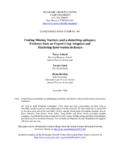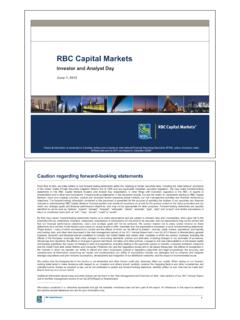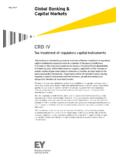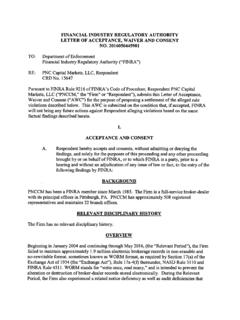Transcription of The State of Agricultural Commodity Markets
1 2015 162015 16 The State of AgriculturalCommodity MarketsTrade and food security: achieving a better balance between national priorities and the collective goodCover photo:A local market in Gambia, part of a FAO project aiming to improve livelihoods and food security through increased Agricultural productivity, marketed output and incomes of the farmers ( FAO/Seyllou Diallo).Key trade in food products continues to expand rapidly, but the structure and pattern of trade differs significantly by Commodity and by region. Key drivers of production and demand, including trade and related policies, shape these patterns in different ways, with potentially important implications for food Greater participation in global trade is an inevitable part of most countries national trade strategies. However, the process of opening to trade, and its consequences, will need to be appropriately managed if trade is to work in favour of improved food security affects each of the four dimensions of food security: food availability, access, utilization and stability.
2 The interaction of trade with these dimensions is complex and depends on a variety of underlying factors, producing great differences in country experiences and making it difficult to ascertain a generalizable relationship. relationship between the level of engagement in trade and food security is influenced by the way food Markets work, by the ability and willingness of producers to respond to the changing incentives that trade can bring, and by the geography of food insecurity, each of which needs to be accounted for in the formulation of trade policy and related policy objectives address different dimensions of food security, will differ across countries, and will change over time. The appropriateness of alternative trade policy options is largely determined by longer-term processes of economic transformation and the role of the agriculture sector within of food price spikes are important for their potential negative impacts on food security.
3 Geopolitical and weather uncertainties, as well as government responses, are likely to exacerbate these episodes in the future, with increasing potential for disruptions to trade flows. The likelihood of price spikes, even if episodic, needs to be factored into longer-term decisions related to the management of trade in food and Agricultural products. and food security concerns can be better articulated in the multilateral trading system through improvements to the World Trade Organization s Agreement on Agriculture. However, the right balance needs to be struck between the benefits of collective action brought through disciplines on the use of trade policy, and the policy space required by developing countries, the identification of which needs to be informed by specific country-level attention from the pros and cons of specific policies towards addressing weaknesses in the governance processes of agriculture and trade policy-making will improve identification of required policy space and its appropriate use.
4 Strengthening these processes requires building synergies to increase policy coherence for food security, to enable governments to balance priorities in the design of trade policies, and to improve their compliance with regional and global trade AND AGRICULTURE ORGANIZATION OF THE UNITED NATIONSRome, 2015 The State of AgriculturalCommodity MarketsTrade and food security: achieving a better balance between national priorities and the collective good2015 16 The designations employed and the pr esentation of material in this information pr oduct do not imply the expression of any opinion whatsoever on the part of the Food and Agriculture Organization of the United Nations (F AO) concerning the legal or development status of any country, territory, city or ar ea or of its authorities, or concerning the delimitation of its fr ontiers or boundaries. The mention of specific companies or pr oducts of manufacturers, whether or not these have been patented, does not imply that these have been endorsed or recommended by FAO in pr eference to others of a similar nature that ar e not 978-92-5-108931-6 FAO, 2015 FAO encourages the use, reproduction and dissemination of material in this information pr oduct.
5 Except where otherwise indicated, material may be copied, downloaded and printed for private study, research and teaching purposes, or for use in non-commercial pr oducts or services, pr ovided that appropriate acknowledgement of FAO as the source and copyright holder is given and that FAO s endorsement of users views, pr oducts or services is not implied in any requests for translation and adaptation rights, and for resale and other commercial use rights should be made via or addressed to information pr oducts ar e available on the FAO website ( ) and can be purchased through designations employed and the presentation of material in the map(s) do not imply the expression of any opinion whatsoever on the part of FAO concerning the legal or constitutional status of any country, territory or sea area, or concerning the delimitation of vAcknowledgements viiAcronyms xiiiExecutive summary ixPart I The changing nature of Agricultural trade 1 1.
6 Agricultural trade in a changing global landscape: context, trends and prospects 2 2. Evolving market structures 8 3. Potential issues related to food imports 11 Part II Trade and food security: conceptual linkages 17 1. Measuring trade and food security: definitions, indicators and approaches 18 2. Analysing the linkages: a conceptual framework 23 3. Trade expansion and the four dimensions of food security 27 4. Determinants of the strength of linkages: Markets in the trade and food security nexus 32 Part III Trade and related policy supportive of food security 35 1. Policies and policy objectives 36 2. Determining the impact of short-term trade policy interventions on food security 38 3. Longer-term structural transformation and defining policy interventions 40 4. Changing patterns of support to agriculture: lessons for the future 46 5.
7 Determinants of national trade strategies 49ivPart IV Towards improved governance for trade and food security 53 1. Food security in the multilateral trading system 54 2. The policy space available to developing countries 56 3. From policies to processes for improving coherence and policy space 62 4. Linking trade and food security in the post-2015 development framework 66 Notes 71vForewordAchieving the eradication of global hunger by 2030 is a key objective of the United Nations system as reflected in the new post-2015 sustainable development agenda. As patterns of consumption and production continue to evolve, trade in Agricultural and food products will play an increasingly important role in ensuring that growing demands from food-deficit countries can be trade in Agricultural and food products has grown rapidly in recent decades, with countries becoming more engaged in this trade, whether as exporters or importers.
8 However, the manner in which countries should increase their engagement in trade is subject to significant debate. Making trade work for, and not against, improved food security and nutrition is a key challenge for policy-makers. While opening to trade can increase the availability of food in importing countries and put downward pressure on consumer prices, it also brings potential risks with it. A greater reliance on international Markets can leave countries vulnerable to short-term market shocks, both those resulting in tighter supplies and increased consumer prices, as well as those resulting from surges in imports and consequent depressions in producer prices. Opening to trade too quickly can undermine domestic production in import-competing sectors a particular issue during earlier stages of Agricultural transformation when the agriculture sector still has a key role to play in driving wider economic growth and as a source of employment for the majority of the rural poor.
9 Although countries with the ability to increase exports are expected to benefit from increasing trade opportunities, trade expansion is not without its risks for these countries either. Increased levels of exports can put upward pressure on domestic consumer prices, which is a particular concern during periods of below average production. Conversely, rapid falls in Commodity prices, such as those observed in the dairy sector during 2015, can create significant difficulties in countries pursuing an Agricultural export-led existence of such risks lies behind most countries propensity to manage trade in Agricultural and food products. Food security and nutrition objectives, particularly in low- and middle-income countries, often provide a key and legitimate rationale for intervention through trade and related policy. Such policies may be targeted at improvements in one or more of the four dimensions of food security and nutrition: availability, access, utilization and stability.
10 However, the design of appropriate policy interventions in the management of trade has proved to be very challenging. Policy-makers need to balance the concerns of different national constituencies, which will be differentially affected by greater openness to trade. They also need to balance the achievement of national food security and nutrition objectives with their obligations under trade agreements to minimize any potentially negative effects of their actions on their trading partners. Complicating matters further is that the appropriateness of alternative trade and related policy interventions will differ across countries, depending on their level of agriculture sector development and the potential role of these sectors in contributing to improved food security and nutrition, and will change over time as these sectors develop. Such challenges vihave contributed to intense debates as to whether, and how, countries should manage trade in Agricultural and food edition of The State of Agricultural Commodity Markets attempts to clarify the role of trade in contributing to improved food security and nutrition and to contribute to the debate on the rationale for, and approaches to, managing trade in Agricultural and food products.














